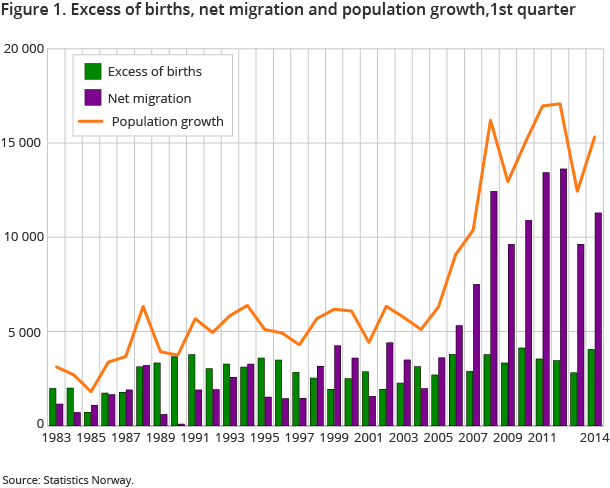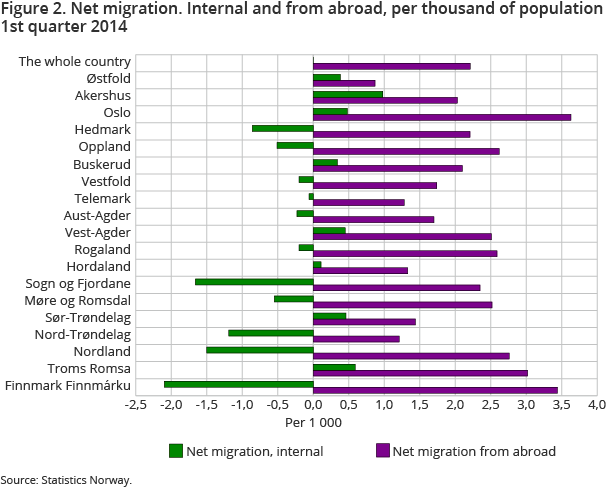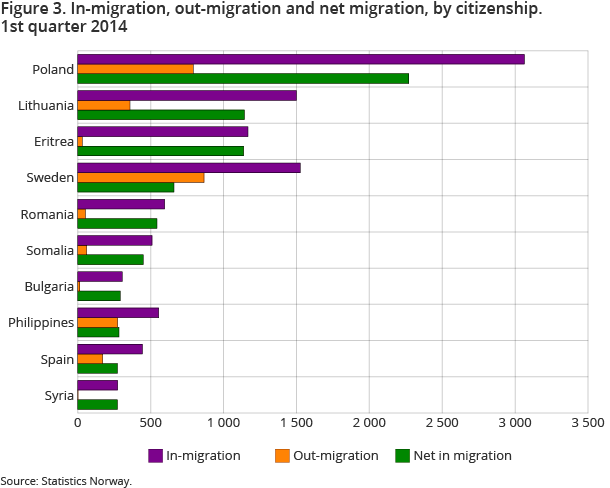Content
Published:
This is an archived release.
High birth surplus in 1st quarter
The population reached 5 124 400 on 1 April. The population increase of 15 300 was almost 3 000 higher than in the same quarter last year. The birth surplus increased by 44 per cent and net migration by 17 per cent.
| 1st quarter 2014 | 1st quarter 2013 - 1st quarter 2014 | ||
|---|---|---|---|
| Number | Per cent | ||
| Population at the beginning of the quarter | 5 109 056 | 57 781 | 1.1 |
| Births | 14 380 | 212 | 1.5 |
| Deaths | 10 335 | -1 028 | -9.0 |
| Excess of births | 4 045 | 1 240 | 44.2 |
| Immigration | 19 133 | 185 | 1.0 |
| Emigration | 7 851 | -1 468 | -15.8 |
| Net migration, immigration and emigration incl | 11 282 | 1 653 | 17.2 |
| Population growth | 15 327 | 2 893 | 23.3 |
| Population at the end of the quarter | 5 124 383 | 60 674 | 1.2 |



A total of 14 400 children were born, which is at the same level as it has been since 1988. A total of 10 300 persons died during the first quarter; 1 000 less than last year. The resulting excess of births of 4 000 was the highest registered since the mid-1970s, with the exception of the 1st quarter of 2010.
There were 19 100 in-migrations from abroad and 7 800 out-migrations to abroad during the first quarter of 2014, giving a total net migration of 11 300. This is 1 600 more than last year, but around 2 000 less than the peak years of 2011 and 2012.
A total of 3 300 of the 7 800 out-migrations – 42 per cent - relate to persons who emigrated a long time ago and did not report their migration to the population register. The Tax Administration carries out ongoing efforts to rectify this in the Central Population Register. This has an influence on the number of out-migrations throughout the year, but particularly for the 1st quarter. In the 1st quarter of 2013, these special registrations amounted to 46 per cent of all out-migrations, while the corresponding figure for the year as a whole was 37 per cent.
The population increase was particularly high in the counties Oslo and Akershus (6 300), as well as Rogaland and Hordaland (3 100). Last year, the increase in Oslo and Akershus was 4 700, and thus the increase this year was 36 per cent from last year.
Highest birth surplus in Oslo
Oslo had the largest birth surplus, also in relation to the population. The birth surplus was 1 500. In the counties Hedmark and Oppland combined, 170 more died than were born. In several of the counties, the birth surplus is very low, and the combined number for six counties (Østfold, Telemark, Aust-Agder, Sogn og Fjordane, Nordland and Finnmark) was just 36.
Substantial immigration of Poles to Norway continues
Of the foreign citizens who immigrated to Norway, the Poles continued to dominate for the ninth successive year. Three other large groups were the Lithuanian, Swedish and Eritrean citizens.
Swedish and Polish citizens were by far the two largest groups emigrating from Norway, with 900 and 800 respectively. The aforementioned special registrations must be taken into account in this connection. Net immigration of Eritrean citizens increased from 700 last year to 1 100, while net immigration of Somali citizens decreased from 600 last year to 400. The corresponding increase for Filipino citizens was 500 last year to 300.
Internal migration loss in many counties
Eleven counties had a migration loss to other counties, while eight had a surplus. The area consisting of the three counties Østfold, Akershus and Oslo had a surplus of 1 000, and the remaining 16 counties therefore had a corresponding loss of 1 000. As usual, Nordland experienced the greatest loss, with 310 more internal out- than in-migrations. Viewed in relation to the population, Finnmark had the largest loss in internal migration.
The statistics is published with Population.
Contact
-
Statistics Norway's Information Centre
E-mail: informasjon@ssb.no
tel.: (+47) 21 09 46 42
